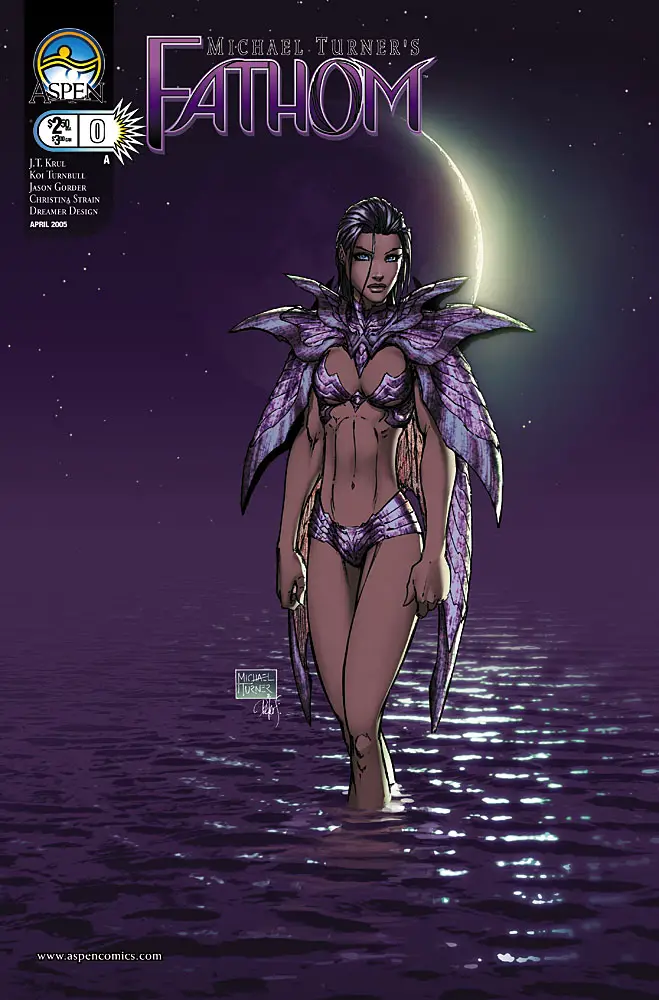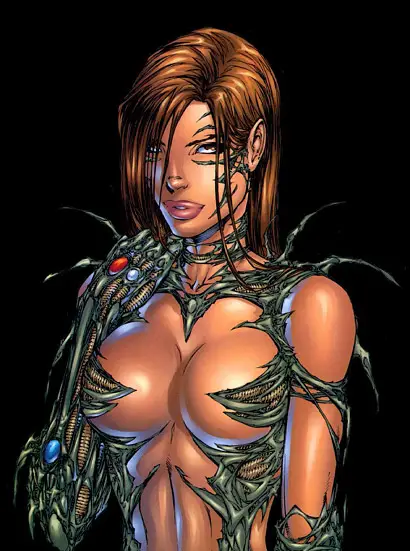A cover of the comic book Fathom drawn by Michael Turner. The superheroine, who possesses water-based powers, is one of Mr. Turner’s most popular character.
World Biography: Michael Turner
Copyright © 1998-2010 Roger A. Lee and History Guy Media; Last Modified: 11.10.10

World Biography:
Michael Turner
Michael Layne Turner (April 21, 1971-June 27, 2008), was an American comic book artist best known for creating the graphically beautiful and alluring female characters, Witchblade and Fathom, which were both published by Top Cow comics. Turner also worked on DC comics titles The Flash , Identity Crisis, Supergirl, and Superman/Batman, and various Marvel comics titles. Michael Turner founded and owned the comic entertainment company Aspen MLT. Turner died of complications from bone cancer in a hospital in Santa Monica, California. More Micheal Turner Art here...
Courtesy of Aspen MLTMichael Turner
Courtesy of Aspen MLTMichael Layne Turner (April 21, 1971-June 27, 2008), was an American comic book artist best known for creating the graphically beautiful and alluring female characters, Witchblade and Fathom, which were both published by Top Cow comics. Turner also worked on DC comics titles The Flash , Identity Crisis, Supergirl, and Superman/Batman, and various Marvel comics titles. Michael Turner founded and owned the comic entertainment company Aspen MLT. Turner died of complications from bone cancer in a hospital in Santa Monica, California.
Family, Career, and Personal Highlights
Spouse: single, though he was engaged to Kelly CarmichaelChildren: none
Mother: Grace Crick
Siblings: Jake Turner
Place of Birth:
Crossville, TennesseeEducation
College: University of Tennessee
Professional Career
1994: Top Cow comics (artist)
Bibliography
Top Cow Comics
- Codename: Strykeforce - #14 (Image 8/1995)
- Ballistic #1-3 (Top Cow). 3-issue solo miniseries of the female character of the Cyberforce series.
- Witchblade #1-8, 10-22 & 25 (Top Cow)
- Tomb Raider/Witchblade and Witchblade/Tomb Raider (Top Cow)
- Fathom (vol. 1) #0, 1/2, 1-14 (Aspen Comics, 2003)
- Superman/Batman #8-13 (DC Comics, 2004) The re-introduction of Kara Zor-El/Supergirl to the DC Universe.
- Soulfire (vol. 1) (Aspen Comics, 2004-2008)
Covers
Variant incentive cover for Justice League of America #12.
DC Comics
- Teen Titans #1 variant cover (DC Comics, July/2003). Two covers were published for this issue in a 50/50 split. The Turner cover was also later used for the first trade paperback of the series.
- Action Comics #812-813, Adventures of Superman #625-626 & Superman #202-203 (DC Comics, January-February/2004). 6-part story arc "Godfall" running for two months in the three main series of Superman, with covers and script (co-written with Joe Kelly) of Turner. The art (pencils, inks and colors) of the six issues were handled by other artists of Aspen MLT.
- Superman #205 (DC Comics, 2004). Variant cover for the second issue of the For Tomorrow story arc in this series. Jim Lee, the story's artist, also drew one variant cover for an issue of the Turner story arc in Superman/Batman (in addition to his duties as regular artist for the Supergirl story).
- Identity Crisis #1-7 (DC Comics, 2004). Turner drew all covers for this series.
- The Flash #207-211 (DC Comics, 2004). Turner drew five covers for this series written by Geoff Johns, who also works in a creator-owned project with him, the series Ekos.
- Wildstorm Winter Special (DC/Wildstorm, November/2004). Cover with the characters Zealot, Apollo, Midnighter, Jack Hawksmoor and Deathblow.
- Supergirl (DC Comics, 2005). Turner drew variant covers for the first issue of this new series, featuring the Kara Zor-El Supergirl's return to continuity in his Superman/Batman story arc.
- Justice League of America #0-12 (DC Comics, 2006-2007). Turner drew various covers, shifting between regular and variants, for the first thirteen issues of the series.
- Superman/Batman #8-13,26 (DC Comics, 2004/2006). Turner drew a first and second print for #8 as well as a variant for #8. He drew one of two covers for #10, the other being drawn by Jim Lee. He drew two covers for #13. He drew both covers for #26, the issue dedicated to the passing of Jeph Loeb's son Sam.
Marvel Comics
- Wolverine: Origins #1 variant cover (Marvel Comics, 2006). The "regular" cover of this issue was done by Joe Quesada.
- Civil War #1-7 (Marvel Comics, 2006-2007). Each issue of the miniseries has three covers, one "regular cover" by series penciller Steve McNiven, one "variant cover" by Turner, and one "sketch variant cover" by Turner.
- Civil War #1 "Aspen Comics exclusive variant cover" (Marvel Comics 2006). Turner also did another cover featuring Iron Man, Captain America, and Wolverine printed as an Aspen Exclusive Variant, much like Civil War: X-Men #1.
- Black Panther #18, & Ms. Marvel #1 (Marvel, 2006). Turner drew variant covers for these two comic-books, that had both regular covers drawn by Frank Cho.
- Ultimate X-Men #75 (Marvel Comics, 2006) To introduce Ultimate Cable in 2006, Marvel commissioned Turner to to the cover for the first book of the story line.
- Incredible Hulk #100 (Marvel Comics, 2006) Turner drew a "green hulk" variant as well as a "gray hulk" variant for this issue.
- Onslaught Reborn #1 (Marvel Comics, 2006) Turner drew a "B" cover with Rob Liefeld drawing the "A" cover for this issue.
- Black Panther #23 (Marvel Comics, 2006) Currently Turner worked on covers for the Black Panther tie in to the Civil War, starting with #23
- Fallen Son: The Death of Captain America #1-5 (Marvel Comics, 2007) Turner drew the variant covers for this entire series in a 50/50 split with the various artists of the individual issues.
- Ultimate Wolverine Turner was set to pencil the covers and interior art for this series, written by Jeph Loeb
- Sub-Mariner #1 and #5 Turner draws the regular cover for these issues.
- World War Hulk Turner drew an Aspen Comics exclusive variant cover for the first issue available at AspenComics.com
- Hulk #1 (Marvel Comics, 2008) Turner drew a "RED" variant cover for the first issue that was only available to advance ticket holders of Wizard Magazine's 2008 Wizard World Comic Convention in Los Angeles, CA.
- Uncanny X-Men #500 (Marvel Comics, 2008) With Greg Land and Alex Ross providing 50/50 variants, Turner drew a chase variant cover featuring some of the most notable male members of the mutant team for this milestone issue, while Terry Dodson utilized female members for his variant.[3]
Links and Resources:
Aspen MLT, Inc
Top Cow Productions, Inc.
Wikipedia Article on Micheal TurnerNew York Times Obit on Michael Turner
Michael Turner, a popular comic-book artist who came to fame in the mid-1990s and was best known for creating two sexy female lead characters, Witchblade and Fathom, died on June 27 in Santa Monica, Calif. He was 37.
The cause was complications from treatment for bone cancer, his colleague Vince Hernandez said in a statement.
Armed with only a hastily assembled five-page sample of his work, Mr. Turner was discovered at a comic-book convention in 1993 by Marc Silvestri, one of seven artists who founded Image Comics in 1992. Within months, Mr. Turner went from waiting tables to being a top-selling artist.
Mr. Turner, along with Mr. Silvestri and a few others, soon created his best-known character, Witchblade, named after a supernatural weapon that affixed itself to the arm of Sara Pezzini, a homicide detective in New York; the transformation left her provocatively clad, armed and dangerous.
The novelist and part-time comic-book writer Brad Meltzer, in a special edition of the comics-industry magazine Wizard that was devoted to Mr. Turner before he died, said: “Anyone who says they didn’t become aware of Mike when they saw one of his hot girl drawings is a liar. That’s when he hit the radar.”
Witchblade first appeared in comic books in 1995 and became the basis of a live-action series on the cable channel TNT in 2001. It ran for about two seasons.
In 1998, Mr. Turner created the aquatic Fathom, published by Top Cow Productions. In her secret identity Fathom was a marine biologist with a model’s looks named Aspen Matthews.
Two years later, Mr. Turner learned he had a type of cancer called chondrosarcoma in his right pelvis. He lost his hip, 40 percent of his pelvis and three pounds of bone and underwent nine months of radiation therapy. He eventually went into remission, only to have the cancer return several times.
In 2002, Mr. Turner founded Aspen MLT, an entertainment publishing company. The L stood for Lane, his middle name, which he rarely used. The company’s comics were delayed by a yearlong legal battle with Top Cow regarding the rights to Fathom and other properties. The case was settled out of court the next year.
In 2004, Mr. Turner began contributing work to DC and Marvel, the comics industry giants. His cover art brought him particular attention, including his illustrations for Identity Crisis, a top-selling seven-part mystery written by Mr. Meltzer, in which DC superheroes, including Superman, Green Arrow and Hawkman, are forced to question their culpability in a vengeful murder.
As with every cover they worked on, “Mike and I spoke at length about the design” of the final one for the project, Mr. Meltzer wrote in an e-mail message. The cover presented the characters as empty costumes, which ambiguously represented either the end of the age of superheroes or a rebirth.
Mr. Meltzer continued: “The only thing we argued about, as only two geeks can: whether Batman’s cowl should be flat and empty, or stiff and armored. I lost. He won. And he was right. But make no mistake, with Mike gone, the capes and cowls are most certainly empty. His covers were the first thing every reader saw. And he was the one true ‘big name’ on the book. That’s why people picked it up.”
Fans were important to Mr. Turner. He was always appreciative of people who stopped to say hello at conventions, and he signed countless autographs, even when he was confined to a wheelchair, Gareb Shamus, the publisher of Wizard, said.
Mr. Turner was born in Crossville, Tenn., on April 21, 1971, and is survived by his mother, Grace, and his brother, Jake.
In high school, Mr. Turner took an art class, but he mostly drew for his own amusement. In 1993, he was encouraged to put together a sampling of his work and to attend the San Diego Comic-Con, the nation’s largest comic convention. It was there he met the staff of Top Cow.
“We gave him his first shot,” Mr. Silvestri said. “That will always be important: that we had a little something to do with bringing Mike to the world of comics.”
One of the first tests for the new artist was to draw a building. It looked awful, “like a lump of bread,” Mr. Silvestri recalled. Still, he found Mr. Turner so affable that they tried again, this time with help from a reference book on New York architecture. The results were remarkable.
“I did a double take,” Mr. Silvestri said. “It was beautiful, incredible. More than I would’ve possibly expected from a seasoned professional. I asked him flat out, ‘Where did this come from?’ He said, ‘No one ever told me to look at a picture before.’ ”
"The History Guy" is a Registered Trademark.
Contact the webmaster
-



